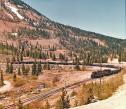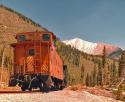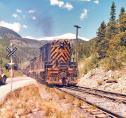
| Home | Open Account | Help | 344 users online |
|
Member Login
Discussion
Media SharingHostingLibrarySite Info |
Railroaders' Nostalgia > Rio Grande's Monarch branch out of Salida, CO.Date: 01/11/14 15:41 Rio Grande's Monarch branch out of Salida, CO. Author: waycar_rider 1981, I went down so I could work the Monarch branch out of Salida, CO. There was a limestone mine up near the top of Monarch Pass. This limestone mine was for Colorado Fuel & Iron at Minnequa (south side of Pueblo) A very good friend would go down and work this branch. In 1981, he could work it as the conductor. So many of the Salida men had retired that no Pueblo conductor want to work it. The crew districts were Pueblo to Salida and Salida to Minturn.
The branch ran west of Salida. It was 21.4 miles in length. We got 25 miles switching in the morning and we received 13 miles in the evening. We received 6 miles for air pay. It was a money maker for us. We worked six days a week. We were off on Sunday. The Monarch branch had one horse shoe curve and one switch back. When we would take the empties up the switch back, we were ready to get off, in case the engineer did not stop. We had about two cars lengths of room on the switch back when we made the stop. Let me tell you, it was a long ways down off the end of the track. There was no bumping post or anything. The track end at the drop off. Yes, we used retainers on the loads coming down grade!!!!!! We had two stations between Salida and the mine. The first station was Maysville which had a siding of 1400 feet. The next station was Garfield. It had a spur track of 400 feet. Garfield there was a switch back up to another level that ran up towards the mine. Once at the mine, there was a derailing spur, three tracks on a curve. Then the tracks ran uphill towards the tipple. There was two tracks beyond the tipple where we would shove the empties. The mine would bring down the cars for loading. If we had 34 cars in Salida, we would take 34 cars out of Salida. We would put 17 cars into the siding at Maysville. We would take the balance of the cars up to the mine. The mine would load out 17 cars. They would be on one of the tracks other than the main line. We would use the other empty track so we could run around the train. We would shove the empties pass the tipple and put hand brakes on the car. We would cut the caboose off. The head brakeman would take the power and he would put it on the track where the loads were. We would roll the caboose into this track with the loads. We would lace up the air hoses and the engineer would pump up the air for about 30 minutes. We would make an air test. Then we would set the retainers on the loads. We would come down the grade with the retainers set. We used retainers all the way to Maysville. When we got back down to Mayfield, we would shove the cars down the main line. If we had more than 17 cars, we would make a cut on the train and we would shove a couple cars into the spur track, so we were off the US Highway 50 road crossing. We went to eat at the Ramada Inn up the hill. When we return from lunch, we would take our loads down to Maysville. We would shove our train into the east end of the siding. We would attach our caboose to the empties that we left there that morning. We would put hand brakes on the loads and knock off the retainers. Run around our train and we would head back to the mine with the other 17 empties. By the time that we got to the mine, they had the cars loaded from the morning spot. The second spot would be loaded for us the following morning. We did the same thing making an air test and putting up retainers. Back down the hill, we went with the second set of loads. When we got close to Maysville, we would close the angle cock on the caboose and bleed it off. The Rio Grande cabooses had a bleed value inside the caboose. We would cut the caboose off on the fly. I would get off the caboose and get on the loads. I would ride down to the switch, as the conductor would roll the caboose down the main line. We made rough joints, making sure that the pins would drop. In 1981, we had two GP30's for our power. It was all the engineer could do getting 17 cars into the siding against the loads that we had left there from our first trip. When the engineer felt that he had enough air built up, we would pull out of the siding. We generally ran him about five cars pass the switch. We would roll the caboose down against our train. We would cut the air in and we would take off to Salida. We had one track that we pulled the train into. The engineer and brakeman would bring the power back up to the depot. We had again cut the caboose off on the fly. We would come against the caboose and put everything into a spur track. As I mentioned, it was a money making job. I was making about $175.00 per day. Now remember this was in 1981. I worked this job the last half of September and the whole month of October until the mine shut down for the winter. 1981 was the last year that the mine was worked for the spring, summer and early fall months. The following year they only loaded limestone for two weeks, then the mine was shut down completely. They were switching over to all electric furnaces at CF&I. Craig Billings was the conductor. He later went to work for Amtrak. We had a really good time working this job. In fact, the train master would come up a couple days a week and buy us lunch. Craig was a like able person. I did have to talk him out of one thing. Where we went around a horse shoe curve, we cross over US Highway 50 a second time. He wanted to cut off the caboose off on this curve, then roll the caboose all the way down to Maysville. I kept telling Craig, no we will not do it!!!!! I said our luck, the caboose would hang up on this curve, then what do we do????? Gary A. Rich Aurora CO All photos were taken June 10, 1974. This was before I hired out on the Rio Grande. 1. Show the tracks up at the mine. The track in the lower foreground was the derailing spur. The train is sitting on one of two load tracks. The main line is just to the left of the engines. Where the caboose is sitting is the track that went up to the tipple. 2. The caboose is coming down the switch back. You can see a car stopped at the US Highwy 50 crossing at Garfield. 3. The head brakeman has lined the switch coming off the switch back and the train is heading down towards Maysville.    Date: 01/11/14 15:45 Re: Rio Grande's Monarch branch out of Salida, CO. Author: waycar_rider A couple more photos of the Monarch Branch.
4. The train is high above US Highway 50 at this location. The train gets closer to Hwy 50 as it nears the horse shoe curve. 5. I ran up the hill side getting this shot of the train. You see the brake shoes are doing their job with the air and retainers set. These photos were taken June 10, 1974. Gary A. Rich Aurora, CO   Date: 01/11/14 16:11 Re: Rio Grande's Monarch branch out of Salida, CO. Author: WAF Oh Jeez, Craig Billings? You're smart to tell him no. With his idea, you might have rolled to who knows where, off the track, likely. He was a character on Amtrak. Great stories about him on Amtrak. He also worked the West Local and the Louviers Local. His dry humor on the radio was precious.
Date: 01/11/14 20:51 Re: Rio Grande's Monarch branch out of Salida, CO. Author: mtnwestrail Great stories and photos, Gary. Thanks for sharing.
Paul Birkholz Sheridan, WY Date: 01/11/14 20:54 Re: Rio Grande's Monarch branch out of Salida, CO. Author: NH2006 I love everything about this post. Wish I had seen them there.
Date: 01/12/14 07:00 Re: Rio Grande's Monarch branch out of Salida, CO. Author: tomstp I followed that run one day in the late 1970's. The train had two GP-30's. The engines would occasionally slip hauling the empty cars west from Maysville. I took many pictures that day which I posted a couple of years ago. Great to hear from Gary who actually worked the run.
I particulary remember the mine workers using hand brakes riding the loaded cars down to the holding tracks. They were not as good as the railroad employees with the hand brakes. The gondolas would couple with a resounding crash. Just before the coupling the men would jump from the cars. Contrast that to the conductor who, using a brake club would handle that caboose so well that the couplers just "kissed" and he didn't jump from the caboose either! Date: 01/12/14 08:09 Re: Rio Grande's Monarch branch out of Salida, CO. Author: PHall If there ever was a run where a road slug set would have been just right for the job, this was it.
An SP GP40-2/TEBU/GP40-2 set probably would have worked real nice here. Date: 01/12/14 14:05 Re: Rio Grande's Monarch branch out of Salad, CO. Author: steve_misky Thanks for the info and pics.
I've driven numerous times over Monarch Pass and always tried to figure out how/where the branch worked. cheers Edited 1 time(s). Last edit at 01/12/14 14:06 by steve_misky. Date: 01/12/14 21:43 Re: Rio Grande's Monarch branch out of Salad, CO. Author: mapboy Thanks for the detailed explanation! Many years ago there was an article in Trains on this branch. Here's the line on a topo map, but the rail lines are not easy to follow- http://mapper.acme.com/?ll=38.54438,-106.29756&z=15&t=T
The current aerial view of the mine on Google Maps- http://goo.gl/maps/yHmlQ The Google Street View where the branch crossed US 50 to enter the mine area- http://goo.gl/maps/9VBbl The current Switchback aerial view- http://goo.gl/maps/k4u8a mapboy Date: 01/13/14 19:06 Re: Rio Grande's Monarch branch out of Salad, CO. Author: 3rdswitch Excellent photos and commentary Gary, glad to see you finally got a scanner! Looking forward to more.
JB Date: 01/14/14 08:47 Re: Rio Grande's Monarch branch out of Salad, CO. Author: Jason-Rose Date: 01/14/14 08:54 Re: Rio Grande's Monarch branch out of Salad, CO. Author: octrax Waycar_rider: EXCELLENT PICS!! Thank you for posting them!! Some of us who haven't been as fortunate to be on "your side of town" get to see the Rio Grande "in your neck of the woods".
Edited 1 time(s). Last edit at 01/14/14 08:55 by octrax. Date: 01/14/14 13:02 Re: Rio Grande's Monarch branch out of Salad, CO. Author: icancmp193 Good article in the IIRC May 1965 TRains Magazine about operations on the Monarch Branch too.
Tom Y Date: 01/14/14 15:16 Re: Rio Grande's Monarch branch out of Salad, CO. Author: chico http://godfatherrails.com/photos/pv.asp?pid=1443
http://godfatherrails.com/photos/pv.asp?pid=1447 http://godfatherrails.com/photos/pv.asp?pid=1451 http://godfatherrails.com/photos/pv.asp?pid=1452 See these photos from John Dziobko, Jr. Of a load coming down the mtn crossing US 50 back in '67 Chico Date: 01/15/14 17:11 Re: Rio Grande's Monarch branch out of Salad, CO. Author: Ballastkicker my dad worked at this mine in the early 30's. He would tell me some of the horror stories about the trains going off the end of the track or coming back down the hill with little or no brakes. He lived in canon city and drove back and forth with some other guys. In 1934 when the snow got so deep they couldn't get to the mine, the mine was closed for the winter and he never went back. Ballastkicker.
Date: 01/16/14 17:41 Re: Rio Grande's Monarch branch out of Salad, CO. Author: DrLoco This is a great look at "traditional" railroading...and how something that sounds so easy on paper is filled with hours of boredom and moments of sheer terror...
Thanks for sharing Gary...It'll be hard to top this post for photos and information, but we all encourage you to keep trying! Date: 01/18/14 18:45 Re: Rio Grande's Monarch branch out of Salad, CO. Author: Rathole Great story and photos Gary! Enjoyed every bit of it!
Date: 05/09/16 18:06 Re: Rio Grande's Monarch branch out of Salad, CO. Author: JLY Rathole Wrote:
------------------------------------------------------- > Great story and photos Gary! Enjoyed every bit of > it! Wasn't this line originally 3 ft Gage and after about 1953 or so standard gaged? Date: 05/11/16 19:38 Re: Rio Grande's Monarch branch out of Salida, CO. Author: WW Monarch was standard gauged in 1956. The various GP's that were used on the Branch were usually equipped with special low-speed dynamic brakes to handle the Branch's low speed limits and 4% (4 1/2% in places) grades. In photo no. 5 above, the low-speed dynamic jumper wire can be seen in the dynamic brake cooling grid on the locomotive.
I lived in Gunnison in the early 1970's and saw trains when I was driving over Monarch many times back then. I didn't have the money for a fancy 35 mm camera in those days, so I have no photos--just memories--from that era. I had relocated by the time the Branch shut down, so I didn't see the end of the Branch until after the track was removed. Edited 3 time(s). Last edit at 05/11/16 19:42 by WW. Date: 05/17/16 16:42 Re: Rio Grande's Monarch branch out of Salida, CO. Author: mtnwestrail Great photos and stories. For those trying to locate the photos along the branch line, DRGW,net has a really nice map along with other info on the branch line: http://www.drgw.net/info/MonarchBranch.
~ Paul Paul Birkholz Sheridan, WY |